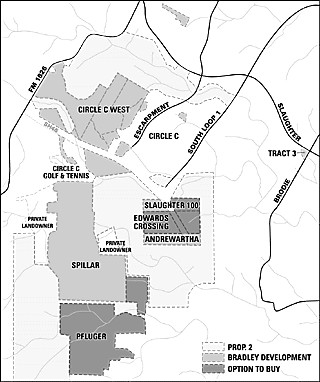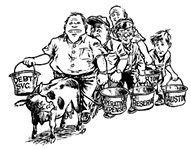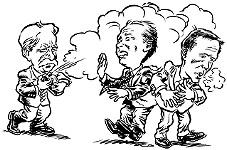Going, Going, Gone?
Bradley Agrees to Sell 1,000 Acres to the City
By Jenny Staff Johnson, Fri., March 17, 2000

The city's acquisition of these properties would allow for some contiguous green space, when combined with the city's existing Prop. 2 properties (light gray).
The 4.5-acre "Tract 3" property, at the intersection of Slaughter and Brodie, would also be deeded to the city as part of the proposed settlement.
Do you really want to save your springs, Austin? If so, it's time to take a hammer to the piggy bank, because developer Gary Bradley has agreed to sell the city nearly 1,000 of the 3,076 acres included in the proposed Bradley settlement -- provided Austin can come up with the money within the next nine months. When the council voted on Thursday to grant preliminary approval to the Bradley settlement, with final approval slated for March 23, the likelihood of a land buy seemed a long way off. But it's getting closer. The council was bound and determined to move the agreement forward Thursday, with Mayor Kirk Watson and the city's legal counsel warning that Bradley's patience -- or, more specifically, the patience of certain of his business partners, whom the agreement also implicates -- is wearing thin. City Attorney Andy Martin said that "if the council wishes to preserve the option to continue to have discussions with Mr. Bradley," there would have to be a show of "good-faith effort" toward getting the thing passed. And pass it just might, especially if a provision is included that would give the city an option to purchase some of the most critical land included in the agreement.
Following a Friday meeting with the SOS Alliance's Robin Rather and John Scanlan, the Save Barton Creek Association's George Cofer, and Council Member Daryl Slusher, Bradley agreed to sell to the city all of Pfluger Ranch, about 70 acres of Spillar Ranch, and 75% of the Edwards Crossing tract (which is zoned for single-family development), for $7,000 to $10,000 an acre -- said to be last year's market price. Should the acquisition materialize, the properties would abut much of the city's Prop. 2 properties -- green space acquired over the last couple of years with voter-approved bonds (see map). The total price tag of about $10 million would not, alas, result in the purchase of the Spillar land on which Bradley plans to build the golf course and hotel -- those are, as outside city attorney Casey Dobson put it, "principal non-negotiable items" in the Bradley settlement -- but at press time Tuesday there were still back-and-forth discussions going on regarding the possible sale of all, or portions of, the Bradley tract.
The land buy is intended to answer the many critics who say the city is not getting enough in return for providing Bradley the utility service he needs to expand his developments over the aquifer. At Thursday's hearing, the call to preserve land was the order of the day. Political consultant Mike Blizzard -- who, though he is affiliated with the SOS Political Action Committee, said he was speaking only for himself -- urged the council to "seek a plan that would preserve specific land and not extend utilities. What, tangibly, does Austin get?" he asked. "Just about everything real, everything tangible, and a lot of concrete goes to Mr. Bradley."
Though 1,000 acres is certainly tangible, it is unclear whether a land buy that doesn't include the hotel and golf course land will be acceptable to Barton Springs purists such as SOS attorney Bill Bunch, who bemoaned the springtime algae blooms that are already covering much of the springs. But it is yet another break in the months-long negotiating process that makes the deal easier to swallow from the city's -- and the public's -- point of view.
Dobson said that the potential land purchase would not impede the progress of the larger Bradley settlement. "The agreement at large is going to go forward," he said, and any land purchase discussions "will proceed on a separate track." He noted that the city could not immediately agree to ink a purchase agreement on the land, because "we don't have the money." But according to Rather, nine months should be enough to raise the necessary cash. And rumor has it that certain council members are favorably considering the suggestion that the city issue yet another bond package to raise all or part of the necessary buyout funds.
Nonetheless, Council Member Daryl Slusher, -- who in a portentous statement on Thursday night promised a "discussion on whether there's any way to get (read: buy) Spillar and Pfluger over the next couple of weeks" -- also warned that "there really is a limit to the amount of money" that the city can spend. "Show me the money," he enjoined the private sector.
And there's no question that well-heeled (and not-so-well-heeled) Austinites will be called to rally behind the cause. While a city bond issue would be the surest way to line up cash, visions of generous-hearted Austinites stepping up to protect their community are already dancing in people's heads. And just imagine, say supporters of raising private money, the benefit concerts and bake sales that could result from such a drive -- possibly even giving rise to another grassroots movement like the one that pushed for passage of the SOS ordinance in the early Nineties. "It could be a unifying thing," said Rather.
Dissension in the Ranks?
Other Bradley settlement highlights from Thursday night include:
Tract 3 will now be sold to the city and preserved from development, in exchange for the waiver of capital recovery fees associated with the hotel project on Spillar Ranch (an amount which has not yet been determined). Tull said that as an additional water quality bonus, the city may be able to build a water treatment plant on the land to treat polluted runoff from Brodie and Slaughter Lane that's currently being returned untreated to the aquifer.
Environmentalists have long lamented the fact that the Rule of Capture was ignored by the Texas Legislature in SB1, the "omnibus" water policy reform bill of 1995, and reaffirmed by the Texas Supreme Court just last year.
The memo, though it expressed dismay that the actions of Governor George W. Bush and the Texas Legislature have painted Austin into this corner, closed with the bottom line as Rather and Cofer see it: "Please," they exhorted the council, "do not lose this opportunity to control these 3,000 acres of recharge zone while you still can."
A Tale of Two NCCDs
The council also approved a resolution initiating a 90-day period to consider whether -- and, if so, how -- to alter the Neighborhood Conservation Combining District (NCCD) governing the Bennett Tract, just east of I-35 off 11th Street, in light of a developer's proposal to build an office tower containing 1.6 million square feet of commercial space. In the early 1990s, a proposal to build a mall on the property went down hard, over charges that the use was inappropriate for the fragile surrounding neighborhood.
Council Member Willie Lewis urged the council to dispense with the formalities and alter the NCCD right then and there: "If we're going to have to get permission from everybody and their brother to do what we're going to do, I can understand why we're here until three in the morning," Lewis said. Assured that such a move would be politically unwise and potentially illegal, Lewis relented, but his support for the change has been duly noted. So has that of soon-to-retire Council Member Gus Garcia, who assured those watching that "I don't want to leave this council without addressing this issue."
Council Member Bill Spelman used the opportunity to reveal his feelings regarding the Hyde Park Baptist Church dispute, from which he routinely recuses himself because his home abuts church property. Spelman contended that both the Bennett tract and the Hyde Park Baptist case call for council intervention to alter old agreements that allow high-density developments to threaten the two neighborhoods. Regarding the two "inappropriate" NCCDs, Spelman said, "I hope we retain the flexibility to change our minds."
Spelman also took the opportunity to take a veiled jab at Watson, who sponsored the Bennett tract item, yet has opposed council intervention in the Hyde Park Baptist case, claiming that "a deal is a deal," and that by altering an NCCD, the council could jeopardize the standing of all agreements regarding neighborhood development. "I hope there is near-unanimous support for that other NCCD that calls for a very intensive use in the wrong place," Spelman said.
Lamar Bridge Delayed
Everybody regrets the recent death of a jogger on the Lamar Street bridge. So it's a shame that the Lamar Street pedestrian bridge, which will take joggers out of the path of danger, has hit yet another snag in its construction. Austin voters first approved bonds to widen the bridge in 1984. But those bonds were never issued, and it was not until the late Nineties that the council returned to the issue. A controversial public process in the summer of 1998 resulted in the current design for the project.
This week, Public Works director Peter Rieck came calling, asking the council what to do in light of the fact that the bids the department got back on the project came in well above the $6million construction budget (bids ranged from $7.98 million to $10.43 million). The department is currently planning to re-bid the project using the current design, which would result in completion on May 31, 2001.
But he presented the council with other options, including the formerly popular "cantilever," which would attach pedestrian lanes to either side of the existing bridge, and which would cost only $4.5 to $5.25 million, but would result in a finish date of Dec. 31, 2002 (or perhaps a little later, since it's probably hard to get a contractor in this town to work on New Year's Eve) The city could also start over with a new design -- a standard-issue, 24-foot wide bridge parallel to the existing bridge, at a cost of $4.8 million, which could be finished by Jan. 31, 2002. Then there's the option city staff has recommended all along, which was identical to what the city is now pursuing, except that it eliminates the bridge extension over Cesar Chavez and Sandra Muriada Way, which takes pedestrians over one more gauntlet of racing traffic. The projected finish date on that option is May 15, 2001.
Fans of the cantilever option (which, they have previously argued, would protect Town Lake vistas by preventing a clutter of bridges along the river) may see a glimmer of hope, but it's probably a slim one: Though cheaper, it has the longest timeline of the four and would cause the greatest disruption of traffic on the already clogged lanes of the existing Lamar Street bridge.
This Week in Council
Council will take a break this week, perhaps to go catch some SXSW gigs. Or perhaps not. In the meantime, some council members will continue doing their homework on the Bradley deal, whichever deal that may be, and reconvene March 23 to pick up where they left off. Got something to say on the subject? Send a letter to the editor.








